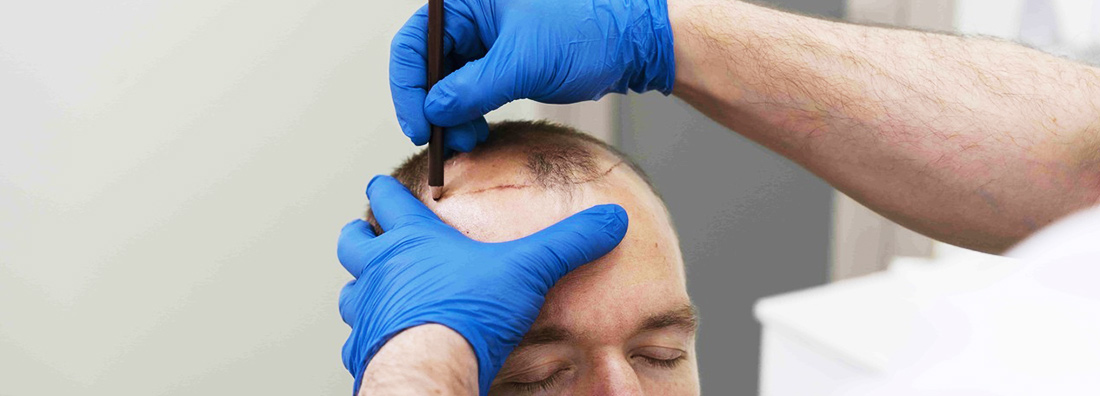
Hair transplantation is a minimally invasive surgical procedure that aims to restore bald areas or areas with low hair density. This is done by redistributing healthy hair follicles, taken from donor areas to areas affected by baldness or hair loss (recipient areas). Unlike artificial hair implants, the transplant uses the patient’s own hair, which significantly reduces the risk of rejection and provides more natural results.
Hair Transplant Techniques
There are 2 hair transplant techniques used in Hera Derma Clinic: DHI and Sapphire FUE
- The DHI (Direct Hair Implantation) technique is one of the most modern methods used today in hair transplant and/or implant surgeries. It consists of implanting the follicular units that were removed using the FUE technique. The implantation of the follicular units is done one by one, manually with a special pen (Choi implanter), resulting in naturalness and greater hair density. With the DHI technique, it is possible to tilt the Choi implanter in different directions (90º, 45º and 30º) following the direction of the native hair with the aim of obtaining natural results.
- FUE (Follicular Unit Extraction) is a hair transplant technique that involves extracting follicular units (i.e. the structures that contain hair) from donor areas (usually the back and sides of the head) and transplanting them to bald areas, delivering a natural-looking result. FUE is the most modern and least invasive hair transplant method in the world, as it does not require large incisions or sutures. With a highly qualified permanent technical team specialized exclusively in hair transplants, we ensure excellence in each stage of the procedure. We use advanced technologies, such as Sapphire blades to guarantee precision and natural results. In addition, we are strict with the density and angle of each implanted follicle, always thinking about the final result, which should bring volume and naturalness to the patient’s hair.
Who Is Hair Transplant for Men Recommended For?
Hair transplantation is recommended for men who suffer from significant hair loss and wish to restore hair density. The main indications include:
- Hereditary baldness (Androgenetic Alopecia): is the most common cause of hair loss in men, characterized by progressive thinning of the hair.
- Post-traumatic hair loss: Patients who have lost hair due to physical trauma, such as burns or scars.
- Correction of previous procedures: people who are dissatisfied with the results of previous hair transplants or have visible scars.
Post-Operative Care
Recovery after a hair transplant is essential for the success of the procedure. Following medical advice is essential to ensure proper healing and healthy growth of new hair. The main precautions include:
- Scalp hygiene: carefully wash the transplanted area as instructed by your doctor, usually with specific products.
- Avoid trauma: protect the area from impacts, do not scratch or rub the scalp.
- Use of medication: follow your doctor’s prescription for antibiotics, painkillers and anti-inflammatories to prevent infections and reduce discomfort.
- Avoid intense physical activity: Avoid exercise and activities that cause excessive sweating for at least two weeks.
- Sun exposure: avoid direct exposure to the sun in the transplanted area for at least one month. If you need to go outdoors, it is recommended to wear a hat or cap.
- No smoking and alcohol: Smoking and alcohol consumption can impair healing and should be avoided during the recovery period.
Since Hera Derma is a dermatology clinic, our specialist physicians perform the necessary medical follow-ups before and after your hair transplantation treatment, analyze your results with the necessary laboratory tests, and apply additional treatments that will support your process.
Expected results and recovery time
The results of a hair transplant are not immediate and require patience. It is important to understand the growth schedule of new hairs to adjust expectations.
Results schedule:
- First few weeks: the transplanted hair may fall out, a process known as “hair loss shock”, which is normal and temporary.
- 1 to 3 months: The follicles enter a resting phase before beginning to grow.
- 4 to 6 months: new hairs begin to appear, initially thin and sparse.
- 6 to 12 months: hair gains density and thickness, becoming more visible.
- 12 to 18 months: final result, with fully grown hair and a natural appearance.
Hair transplantation is an effective and long-lasting solution for hair loss, providing natural results and significantly improving patients’ self-esteem. With modern techniques we use, it is possible to customize the procedure according to individual needs. If you are considering this option, schedule an appointment here at Hera Derma Clinic and consult our qualified specialists to assess your case and advise on the best approach.

